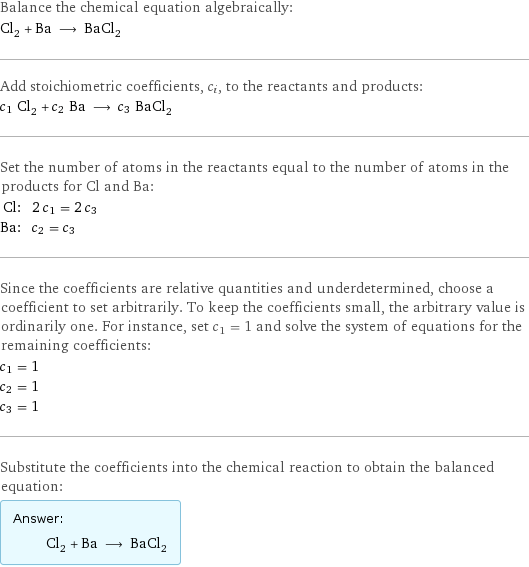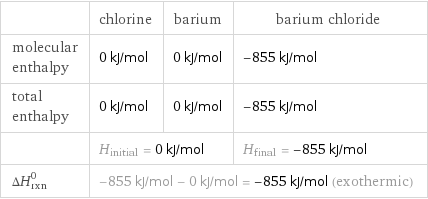Input interpretation

Cl_2 chlorine + Ba barium ⟶ BaCl_2 barium chloride
Balanced equation

Balance the chemical equation algebraically: Cl_2 + Ba ⟶ BaCl_2 Add stoichiometric coefficients, c_i, to the reactants and products: c_1 Cl_2 + c_2 Ba ⟶ c_3 BaCl_2 Set the number of atoms in the reactants equal to the number of atoms in the products for Cl and Ba: Cl: | 2 c_1 = 2 c_3 Ba: | c_2 = c_3 Since the coefficients are relative quantities and underdetermined, choose a coefficient to set arbitrarily. To keep the coefficients small, the arbitrary value is ordinarily one. For instance, set c_1 = 1 and solve the system of equations for the remaining coefficients: c_1 = 1 c_2 = 1 c_3 = 1 Substitute the coefficients into the chemical reaction to obtain the balanced equation: Answer: | | Cl_2 + Ba ⟶ BaCl_2
Structures

+ ⟶
Names

chlorine + barium ⟶ barium chloride
Reaction thermodynamics
Enthalpy

| chlorine | barium | barium chloride molecular enthalpy | 0 kJ/mol | 0 kJ/mol | -855 kJ/mol total enthalpy | 0 kJ/mol | 0 kJ/mol | -855 kJ/mol | H_initial = 0 kJ/mol | | H_final = -855 kJ/mol ΔH_rxn^0 | -855 kJ/mol - 0 kJ/mol = -855 kJ/mol (exothermic) | |
Equilibrium constant
![Construct the equilibrium constant, K, expression for: Cl_2 + Ba ⟶ BaCl_2 Plan: • Balance the chemical equation. • Determine the stoichiometric numbers. • Assemble the activity expression for each chemical species. • Use the activity expressions to build the equilibrium constant expression. Write the balanced chemical equation: Cl_2 + Ba ⟶ BaCl_2 Assign stoichiometric numbers, ν_i, using the stoichiometric coefficients, c_i, from the balanced chemical equation in the following manner: ν_i = -c_i for reactants and ν_i = c_i for products: chemical species | c_i | ν_i Cl_2 | 1 | -1 Ba | 1 | -1 BaCl_2 | 1 | 1 Assemble the activity expressions accounting for the state of matter and ν_i: chemical species | c_i | ν_i | activity expression Cl_2 | 1 | -1 | ([Cl2])^(-1) Ba | 1 | -1 | ([Ba])^(-1) BaCl_2 | 1 | 1 | [BaCl2] The equilibrium constant symbol in the concentration basis is: K_c Mulitply the activity expressions to arrive at the K_c expression: Answer: | | K_c = ([Cl2])^(-1) ([Ba])^(-1) [BaCl2] = ([BaCl2])/([Cl2] [Ba])](../image_source/ac7e7b65481252609ff9f2e2e4e2974b.png)
Construct the equilibrium constant, K, expression for: Cl_2 + Ba ⟶ BaCl_2 Plan: • Balance the chemical equation. • Determine the stoichiometric numbers. • Assemble the activity expression for each chemical species. • Use the activity expressions to build the equilibrium constant expression. Write the balanced chemical equation: Cl_2 + Ba ⟶ BaCl_2 Assign stoichiometric numbers, ν_i, using the stoichiometric coefficients, c_i, from the balanced chemical equation in the following manner: ν_i = -c_i for reactants and ν_i = c_i for products: chemical species | c_i | ν_i Cl_2 | 1 | -1 Ba | 1 | -1 BaCl_2 | 1 | 1 Assemble the activity expressions accounting for the state of matter and ν_i: chemical species | c_i | ν_i | activity expression Cl_2 | 1 | -1 | ([Cl2])^(-1) Ba | 1 | -1 | ([Ba])^(-1) BaCl_2 | 1 | 1 | [BaCl2] The equilibrium constant symbol in the concentration basis is: K_c Mulitply the activity expressions to arrive at the K_c expression: Answer: | | K_c = ([Cl2])^(-1) ([Ba])^(-1) [BaCl2] = ([BaCl2])/([Cl2] [Ba])
Rate of reaction
![Construct the rate of reaction expression for: Cl_2 + Ba ⟶ BaCl_2 Plan: • Balance the chemical equation. • Determine the stoichiometric numbers. • Assemble the rate term for each chemical species. • Write the rate of reaction expression. Write the balanced chemical equation: Cl_2 + Ba ⟶ BaCl_2 Assign stoichiometric numbers, ν_i, using the stoichiometric coefficients, c_i, from the balanced chemical equation in the following manner: ν_i = -c_i for reactants and ν_i = c_i for products: chemical species | c_i | ν_i Cl_2 | 1 | -1 Ba | 1 | -1 BaCl_2 | 1 | 1 The rate term for each chemical species, B_i, is 1/ν_i(Δ[B_i])/(Δt) where [B_i] is the amount concentration and t is time: chemical species | c_i | ν_i | rate term Cl_2 | 1 | -1 | -(Δ[Cl2])/(Δt) Ba | 1 | -1 | -(Δ[Ba])/(Δt) BaCl_2 | 1 | 1 | (Δ[BaCl2])/(Δt) (for infinitesimal rate of change, replace Δ with d) Set the rate terms equal to each other to arrive at the rate expression: Answer: | | rate = -(Δ[Cl2])/(Δt) = -(Δ[Ba])/(Δt) = (Δ[BaCl2])/(Δt) (assuming constant volume and no accumulation of intermediates or side products)](../image_source/437f53fb2cb7104cddb314e1390c523d.png)
Construct the rate of reaction expression for: Cl_2 + Ba ⟶ BaCl_2 Plan: • Balance the chemical equation. • Determine the stoichiometric numbers. • Assemble the rate term for each chemical species. • Write the rate of reaction expression. Write the balanced chemical equation: Cl_2 + Ba ⟶ BaCl_2 Assign stoichiometric numbers, ν_i, using the stoichiometric coefficients, c_i, from the balanced chemical equation in the following manner: ν_i = -c_i for reactants and ν_i = c_i for products: chemical species | c_i | ν_i Cl_2 | 1 | -1 Ba | 1 | -1 BaCl_2 | 1 | 1 The rate term for each chemical species, B_i, is 1/ν_i(Δ[B_i])/(Δt) where [B_i] is the amount concentration and t is time: chemical species | c_i | ν_i | rate term Cl_2 | 1 | -1 | -(Δ[Cl2])/(Δt) Ba | 1 | -1 | -(Δ[Ba])/(Δt) BaCl_2 | 1 | 1 | (Δ[BaCl2])/(Δt) (for infinitesimal rate of change, replace Δ with d) Set the rate terms equal to each other to arrive at the rate expression: Answer: | | rate = -(Δ[Cl2])/(Δt) = -(Δ[Ba])/(Δt) = (Δ[BaCl2])/(Δt) (assuming constant volume and no accumulation of intermediates or side products)
Chemical names and formulas

| chlorine | barium | barium chloride formula | Cl_2 | Ba | BaCl_2 name | chlorine | barium | barium chloride IUPAC name | molecular chlorine | barium | barium(+2) cation dichloride
Substance properties

| chlorine | barium | barium chloride molar mass | 70.9 g/mol | 137.327 g/mol | 208.2 g/mol phase | gas (at STP) | solid (at STP) | solid (at STP) melting point | -101 °C | 725 °C | 963 °C boiling point | -34 °C | 1640 °C | density | 0.003214 g/cm^3 (at 0 °C) | 3.6 g/cm^3 | 3.856 g/cm^3 solubility in water | | insoluble | surface tension | | 0.224 N/m | odor | | | odorless
Units
